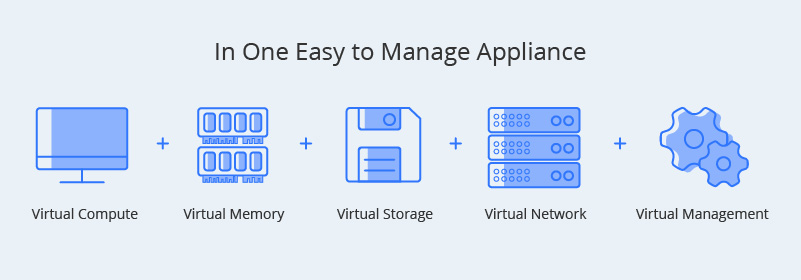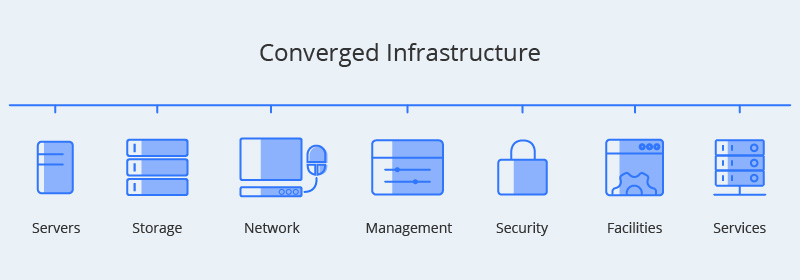Hyper-Converged Infrastructure vs Converged Infrastructure
As technology continues to evolve, virtualization is becoming increasingly prevalent in the enterprise. The greater the demand for the storage, the more redundant data is generated by the virtualization workloads. Thus prompting the development of the Hyper-Converged Infrastructure (HCI) and Converged Infrastructure (CI) which are the solutions to optimize the networks in scalability and management. What are HCI and CI? What differentiates hyper-converged and converged infrastructure? Here, we will make a detailed comparison between hyper-converged and converged infrastructure.
What Is Hyper-Converged Infrastructure?
The HCI is an information infrastructure that integrates virtual compute resources and devices. It can combine storage, compute and network connectivity into a single chassis or node to help reduce data center complexity and increase scalability. Also, it adds a layer of virtualization software that manages all of the resources in a node or cluster as flexible pools.
The hyper-converged infrastructure is defined by software to maximize data center capacity and scalability, and data availability. At the same time, it takes the virtual machine as the core and improves the computing performance and storage space of the cluster. In the hyper-converged architecture mode, the virtual machine and storage space used by the user are constructed by using the software, thus the underlying physical device and the user are kept in an isolated state to realize the complete integration of the virtualization platform and hardware resource. The user can add nodes in a stack form, thereby expanding the cluster capacity of the hyper-converged architecture.

Figure 1: Hyper-Converged Infrastructure
What Is Converged Infrastructure?
The converged infrastructure is designed for integrating multiple information technology components, including servers, data storage devices, network equipment and IT infrastructure management, automation and business process software, to form a single, optimized computing solution. Meanwhile, the CI combines storage and computing into a single physical appliance that is small, dynamic and powerful to minimize compatibility issues between storage systems, servers, and network devices. Available in all-flash, hard disk, and hybrid arrays, CI consolidates platforms while making it easier to add new components.

Figure 2: Converged Infrastructure
Hyper-Converged vs Converged Infrastructure
Though both HCI and CI solve multi-tiered IT infrastructure problems, they are very different. Here, we will make a comparison between HCI and CI through the perspectives of components, principles, rack systems, and advantages.
Components
The CI defines compute, storage, networking, and server virtualization—which are the four core components in a data center—as one dense building block. The HCI is born from converged infrastructure and the idea of the software-defined data center (SDDC). Besides the data center’s four core components, hyper-converged infrastructure integrates more components such as backup software, snapshot capabilities, data deduplication, inline compression, WAN optimization and so on.
Principle
The hyper-converged infrastructure is software-defined. It means the infrastructure operations are logically separated from the physical hardware, and all components in a hyper-converged infrastructure have to stay together to function correctly. The HCI is often deployed on commodity components, providing a simplified scale-out architecture with commodity servers. Software running on each server node distributes all operating functions across the cluster for superior performance and resilience.
The CI relies on hardware and employs building blocks. Each component in a converged infrastructure is discrete and can be used for its intended purpose. You can take it apart and stand-alone devices can be used as they are. For example, the server can be removed and utilized on its own and you can isolate and use individual storage units independently. CI can monitor the capacity of your data center infrastructure through data recognition within private or enterprise clouds and data centers.

Figure 3: Hyper-Converged and Converged Infrastructure Principle
Rack System
Both HCI and CI involves the rack system. Hyper-converged infrastructure normally consists of a one or two rack units that consolidate one or more multi-core servers with a local storage array. While the CI is a large rack-scale platform that merges compute, storage and networking into a single physical appliance.
Advantages
There are several highlighted merits for HCI, such as fast deployment, world-class platform, 100% software-driven, unprecedented flexibility and so on. Besides that, the hyper-converged infrastructure has a storage controller function that can run as a service on every node in the cluster. All these characteristics help to build a fast, efficient and highly scalable enterprise datacenter.
Plug-and play solution, improved agility and efficiency, eliminating compatibility issues, and on-demand growth model are the typical features of the converged infrastructure. With the help of the CI, you can implement a pool of computing, storage, and network resources that can be shared and centrally managed by multiple applications, helping to consolidate systems, increase resource utilization, and reduce operational costs.
Cost
Hyper-converged infrastructure allows IT to build, scale and protect your IT infrastructure more affordably and effectively. The HCI offers a streamlined solution for acquisition, deployment, and management which reduces costs and increases productivity of staff and even improves profitability.
With the converged infrastructure, the IT specialists don’t need to do many repetitive tasks to keep the system up and running, which helps to reduce redundancy. Thus saving the support and maintenance costs.
Conclusion
From the above description, the hyper-converged and converged infrastructure are the two basic solutions to optimize the networks in scalability and management in the enterprise. Comparing to the CI, the HCI is a fast-growing and more valuable technology segment in the industry today. Also, it also helps to become a new engine for the convergence of cloud computing and big data chain, further helping the rapid transformation and upgrading of the IT industry.
Related Article
FS S5800-8TF12S Switch: Key Choice for Hyper-Converged Infrastructure Solution
You might be interested in
Email Address

-
PoE vs PoE+ vs PoE++ Switch: How to Choose?
Mar 16, 2023














